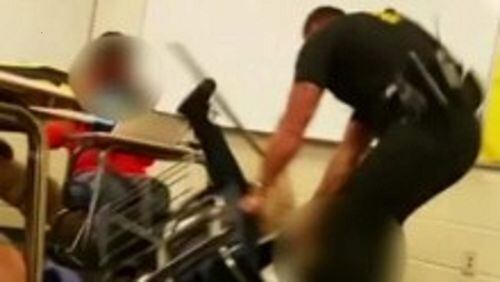A report released this morning examines the rise of school-based police officers, their latitude in deciding whether to send students to the principal's office or juvenile court and the consequences to girls of color.
Today, police officers -- known as school resource officers or SROs -- are common in public schools. Nationwide, there are more than 19,000 officers in schools, up from about 100 in the 1970s, according to the Georgetown Law Center on Poverty and Inequality and the National Black Women’s Justice Institute new report, which notes, "Although the purpose of these officers is to maintain safety and address criminal acts, an important unintended consequence is greater arrest rates and referrals in schools who retain them, with especially harsh results for girls of color. "
The report, "Be Her Resource: A Toolkit about School Resource Officers and Girls of Color," builds on a report earlier this year from Georgetown Law Center on Poverty and Inequality that found black girls are regarded as older and less innocent than white counterparts, a bias that particularly affects girls between the ages of 5 and 14. Girlhood Interrupted: The Erasure of Black Girls' Childhood, suggested this "adultification" contributed to the disparate discipline of black girls in schools and their harsher treatment in the juvenile justice system.
The new report provides a blueprint for schools to better train officers after many of the officers interviewed cited a lack of guidance.
trauma-informed and healing-centered responses, and punitive roles limited strictly to criminal law enforcement.
Among the recommendations:
- Clearly delineate law enforcement roles and responsibilities in formal agreements.
- Collect and review data that can be disaggregated by race and gender.
- Implement non-punitive, trauma-informed responses to girls of color.
- Offer specialized training to officers and educators on race and gender issues and children's mental health.
In their interviews with researchers, girls said the SROs urged them to be “ladylike” and "respectable" or to "present themselves in schools in traditionally defined professional and non-confrontational ways." While many people on this blog will counter there's nothing wrong with fostering ladylike behavior, the question is whether the point is to encourage manners or subservience.
Girls of color told researchers they see bias in the responses of officers. One participant related this anecdote:
"Why did it have to be 'what did I say to her?' Why couldn't it be, 'Who started it first?' or 'What's going on? What happened?' …
Some states including Georgia have made it a crime to disrupt school, giving SROs the ability now to escalate student misbehaviour from school principals to criminal courts. (Interesting footnote: Disrupting school was first criminalized in the late 1960s in response to high-school and college civil rights demonstrations.) But, as earlier research has documented, many discipline decisions are subjective, based on such offenses as "willful defiance."
The report notes:
About the Author







